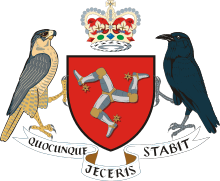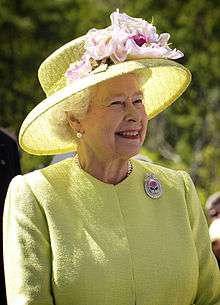Lord of Mann
The Lord of Mann (Manx: Çhiarn Vannin) is the Lord Proprietor[1][2] and head of state of the Isle of Mann. The current lord proprietor and head of state is Elizabeth II.
| Lord of Mann | |
|---|---|
 | |
| Incumbent | |
 | |
| Elizabeth II | |
| Details | |
| Style | Her Majesty |
| Heir apparent | Charles, Prince of Wales |
| First monarch | George III |
| Formation | 1504 |
 |
|---|
| This article is part of a series on the politics and government of the Isle of Man |
Relationship with the Crown
The title is not correctly used on its own. Since 1399, the kings and lords of Mann were vassals of the kings of England, and subsequently of Great Britain and the United Kingdom, who was the ultimate sovereign of the island. This right of 'Lord Proprietor' was revested into the Crown by the Isle of Man Purchase Act 1765 for £70,000 and a £2,000 annuity, and hence ceased to exist separately. King George III became the first British monarch to reign over the Isle of Man as Lord of Mann in 1765.[3] However, for reasons of culture and tradition, the title Lord of Mann continues to be used. For these reasons, the correct formal usage, as used in the Isle of Man for the Loyal Toast, is The Queen, Lord of Mann.
The title is now Lord of Mann regardless of gender. However, during her reign, Queen Victoria was styled as Lady of Mann.[4]
The formal Latin style is Dominus Manniae.
List of lords
- Prior to 1504, the ruler of the Isle of Man was generally styled King of Mann.[5]
16th century
- Thomas, Earl of Derby, 1504–1521
- Edward, Earl of Derby, 1521–1572
- Henry, Earl of Derby, 1572–1593
- Ferdinando, Earl of Derby, 1593–1594
Succession dispute (1594–1607)
In 1598, a succession dispute between the daughters of Ferdinando and their uncle, William, Earl of Derby was heard by the Privy Council. They decided that the right to the Isle of Man belonged solely to Queen Elizabeth I, and the letters patent of 1405 which conferred the lordship of the Isle of Man on the Stanley family were declared null and void as the previous ruler, Henry, Earl of Northumberland, had not been subject to legal attainder, despite his treason, and the 1405 and 1406 letters patent had therefore not taken effect.[6][7]
The Queen, in consideration of the "many eminent services performed to herself and to her royal predecessors by the honourable and noble House of Stanley", withdrew her right and referred the contending claimants to the decision of the Privy Council as to the best claim of inheritance.
The Law Lords on the Privy Council decided "the grant being by letters patent under the Great Seal of England, such right would descend according to the Common Law of England to the heirs general, and not to the heirs male", and the island was therefore awarded to Ferdinando's daughters; whereupon William agreed to purchase their several shares and interests.[8]
The original letters patent having been declared void, the Parliament of England in 1609 under James I passed a Private Act of Parliament entitled "An Act for assuring and establishing the Isle of Man in the name and blood of William, Earl of Derby" [(1609) 7 Jac.1 c.4][9] which established the title in law as Lord of Mann. The lordship was conferred by letters patent dated 7 July 1609 upon William Stanley, 6th Earl of Derby.[10] Subsequent succession was under the terms of this grant.[11]
Interim lords (1607–1609)
Following the resolution of the succession dispute, it was ruled that the daughters of Ferdinando Stanley were the rightful heirs. As the oldest of them would not reach the age of majority until 1609, two temporary Lords of Mann were appointed by James I by letters patent,[12] so that the daughters could benefit from the Island's revenues.
- Henry, Earl of Northampton, 1607–1608
- Robert, Earl of Salisbury, 1608–1609
Following the coming of age of the heirs, the rights over the island were sold to their uncle, William Stanley. He took up the title of Lord of Mann following the passing of an Act of Parliament.[13]
17th and 18th centuries
- William, Earl of Derby, 1609–1612
- Elizabeth, Countess of Derby, 1612–1627
- James, Earl of Derby, 1627–1651 (known as the Great Stanley)
- Thomas, Lord Fairfax of Cameron, 1651–1660 (appointed by Oliver Cromwell during the English Interregnum)
- Charles, Earl of Derby, 1660–1672 (restored by Charles II)
- William, Earl of Derby, 1672–1702
- James, Earl of Derby, 1702–1736
- James, Duke of Atholl, 1736–1764
- Charlotte, Duchess of Atholl and John, Duke of Atholl, 1764–1765
Revestment
In 1765, Charlotte Murray, Duchess of Atholl, 8th Baroness Strange, sold the suzerainty of the island to the British government for £70,000 and an annuity of £2,000 (£5,235,000 and £150,000 respectively in modern terms). By the passage of the Isle of Man Purchase Act 1765 the title of Lord of Mann was revested into the British Crown. It has therefore since been used in the Isle of Man to refer to the reigning British monarch.
In 1828, all remaining property interests and rights of the dukes of Atholl on the island were sold to HM Treasury, a department of the British government, for the sum of £417,144, equivalent to £35,990,582 in 2019.[14][15] This was accomplished by two Private Acts of Parliament:
- "An Act empowering the Lords of the Treasury to Purchase all the Manorial Rights of the Duke of Atholl in the Isle of Man" [c. 34] 10 June 1824
- "An Act to empower the Commissioners of His Majesty’s Treasury to purchase a certain Annuity in respect of Duties and Customs levied in the Isle of Man, and any reserved sovereign rights in the said Island belonging to John Duke of Atholl" [c. 34] 10 June 1825
Lieutenant governor
The lord of Mann is now represented by the lieutenant governor of the Isle of Man.
See also
References
- Archived December 3, 2008, at the Wayback Machine
- "A new electorate for the Isle of Man". BBC News. 19 November 2006. Retrieved 11 May 2010.
- "The official website of The British Monarchy". Royal.gov.uk. Archived from the original on October 29, 2013. Retrieved 2013-10-27.
- "Contents - From King Orry to Queen Victoria, 1899". Isle-of-man.com. Retrieved 2013-10-27.
- Archived May 30, 2007, at the Wayback Machine
- Callow, Edward (2007), From King Orry to Queen Victoria: A Short and Concise History of the Isle of Man, Gardners Books, ISBN 1-4326-8295-4
- "Note 20 - ManxSoc Vol 12 Parr's Abstracts". Isle-of-man.com. Retrieved 2013-10-27.
- "William, Sixth Earl of Derby". Isle-of-man.com. Retrieved 2013-10-27.
- Mills, M A (1821), Ancient Ordinances and Statute Laws of the Isle of Man, Douglas, pp. 522–527
- Mills, op. cit, pp.514–522
- Manx Independent: 30 November 2007 Archived 14 December 2007 at the Wayback Machine. 29 November 2007. iomtoday.co.im. Retrieved on 22 December 2007
- "pp88 - Manx Soc vol 9 'Monumenta de Insula Manniae - Vol 3'". Isle-of-man.com. Retrieved 2013-10-27.
- An Act for assuring and establishing the Isle of Man in the name and blood of William, Earl of Derby, 1909, Private Act c.4
- "Currency converter". The National Archives. Retrieved 2012-07-06.
- "History Pages Isle of Man -Act of Revestment". Isle-of-man.com. Retrieved 2013-10-27.